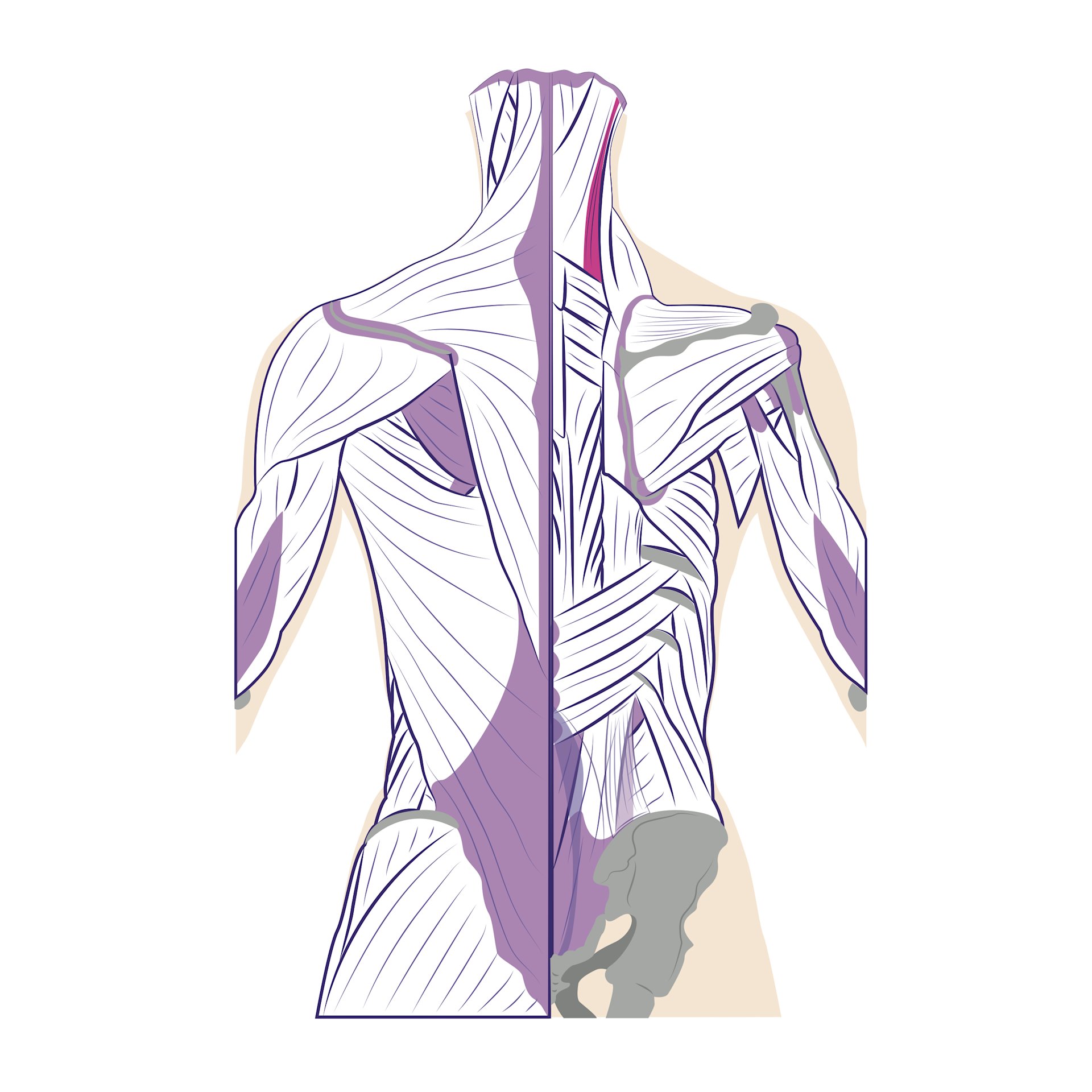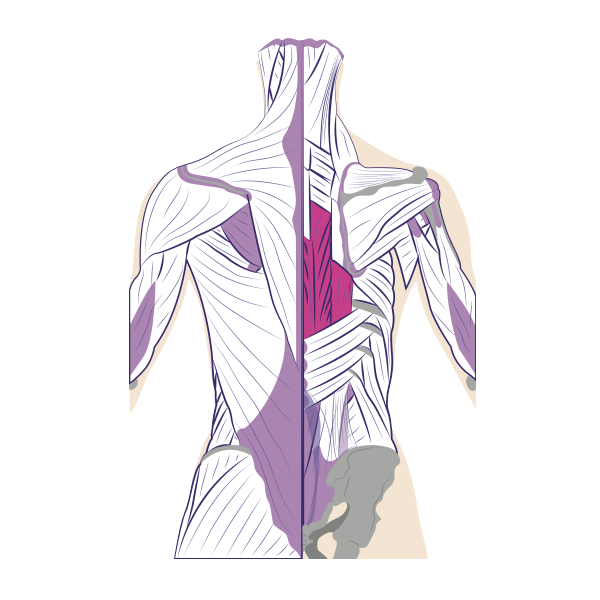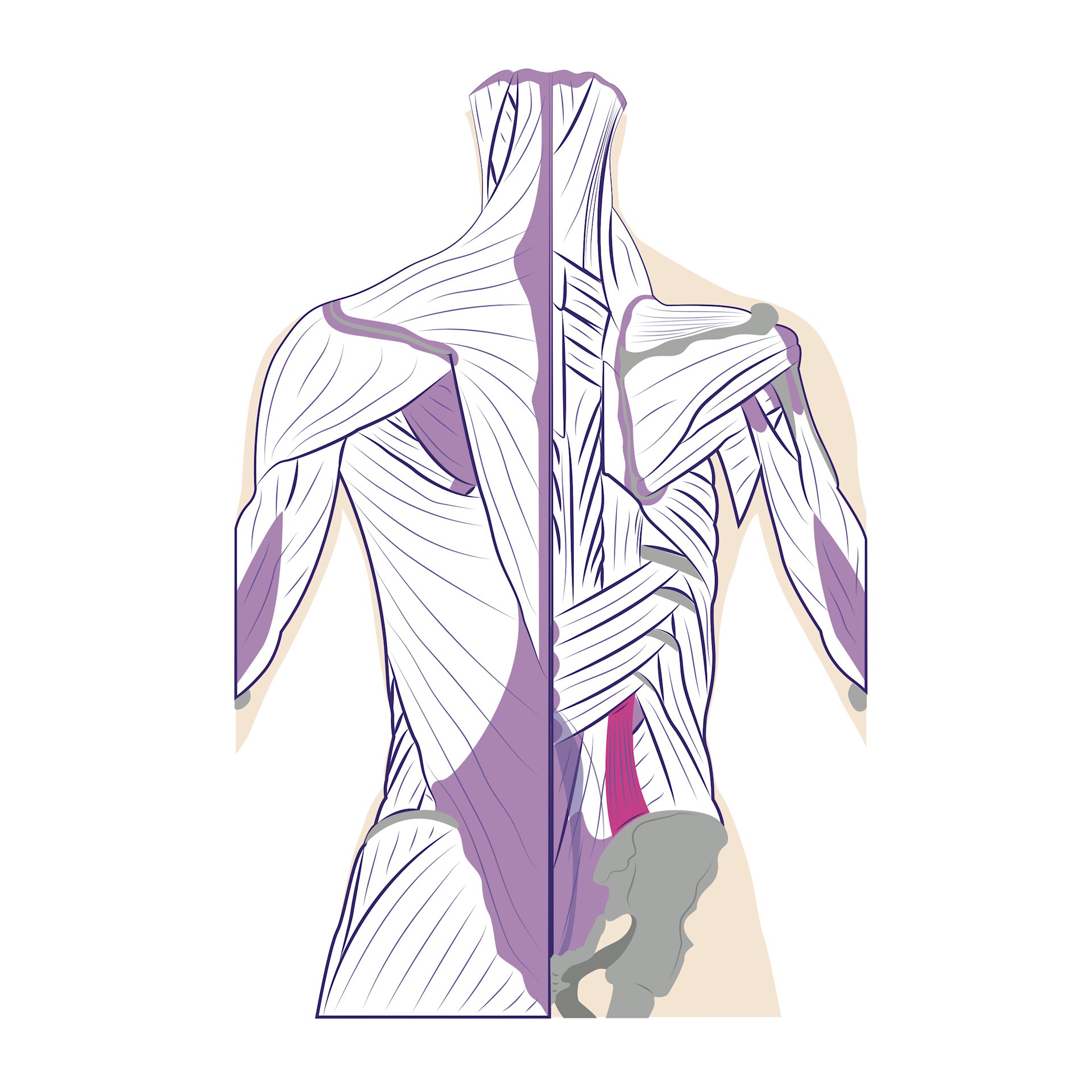OVERVIEW
Back pain is personal.
Each ache and pain is different, that's why Goodpath takes a personalized approach to creating back pain programs. Each program is designed to get you on the path back to better health.
Our algorithm builds well-rounded programs based on your symptoms, lifestyle details, and medical history. Click below to take a 3-4 minute assessment.
This page has been reviewed by the GoodPath medical team. Medical Writer: Beth Holloway, RN, M. Ed; Medical Reviewer: Stephanie Gianoukos, MD, MPH; Updated: November 2020.
## The Back’s StructureThe back’s structure is complex. It is made of the spine, discs, nerves, muscles, tendons, ligaments, and other structures. Each of these parts are individual structures, which function or work together. Here’s how:
The __spine__ is made up of bones called vertebrae. __Ligaments__ hold the vertebrae together. Between each vertebrae, __discs__ provide cushioning. __Nerves__ extend through small holes in the vertebrae to different parts of the body. __Tendons__ attach the __muscles__ to the vertebrae. These muscles support the spine and allow for movement.
### MusclesThe back’s muscles start at the top of the back (called the cervical vertebrae) and go to the tailbone (also called the coccyx).
Some of these muscles are quite large and cover broad areas. Other muscles are small and cover much less space. Certain back muscles extend to other areas, like the shoulders, upper arms, and thighs.
### Types of MusclesThere are three different types of muscles in the body: the heart muscle, smooth muscles, and skeletal muscles.
The back muscles are skeletal muscles. They support bones, in this case, the vertebrae. By tightening and relaxing, the skeletal muscles create movement.
### Parts of the MuscleEvery skeletal muscle has three main parts: *the origin, insertion, and belly.*
A muscle’s origin is where a tendon attaches it to the *less* movable bone. On the other hand, the insertion is where a tendon attaches that muscle to the *more* movable bone. The fleshy, thick part of the muscle is called its belly.
### Tendons
In the back and elsewhere in the body, tendons attach muscles to bones. They help support particular bones and make them move.
Learn the basics of back anatomy.
Bones (called vertebrae), discs, supporting muscles, tendons, ligaments, and other structures make up the back. Any combination of these may be involved in back pain.
When specific areas of the back are involved in back pain, they are named for the spine in those same areas.
Neck pain may be called cervical pain, like the cervical spine.
Upper back pain may be called thoracic pain, like the thoracic spine.
Lower back pain may be called lumbar pain, like the lumbar spine. It is also known as lumbago.
## Types of Back InjuriesMuscle or tendon injuries can occur anywhere in the body. They are common in the back and usually cause pain. The names of the muscles and their locations can help pinpoint the muscle involved.
One type of injury – a strain – means that a muscle or tendon has stretched or torn. Sometimes, muscles and tendons are strained at the same time.
### Muscle InjuriesMany people have experienced or heard of a strained muscle (also called a pulled muscle). These terms describe a stretched or torn muscle. Strained muscles can occur anywhere in the back, but they often affect the lower back (lumbar area).
What could cause a muscle strain? Recovering from quick movements like a loss of balance.
Tendon Injuries
Like muscles, tendon stretches and tears are also called strains.
What could cause a tendon strain? Overusing a tendon without allowing for rest.
Muscle and Tendon Injuries
There are tendons at the ends of the muscles, which attach to the bone. So, activities that cause a strain could injure both the muscle and tendon at the same time.
What could cause a muscle and tendon strain? Bending and lifting a heavy package.
Learn the basics of back anatomy.
Bones (called vertebrae), discs, supporting muscles, tendons, ligaments, and other structures make up the back. Any combination of these may be involved in back pain.
When specific areas of the back are involved in back pain, they are named for the spine in those same areas.
Neck pain may be called cervical pain, like the cervical spine.
Upper back pain may be called thoracic pain, like the thoracic spine.
Lower back pain may be called lumbar pain, like the lumbar spine. It is also known as lumbago.
Muscle Groups in the Back
As with other parts of the body, the back has several layers of muscles. Some are closer to the surface (called superficial muscles). Moving deeper into the body, there are intermediate muscles and deep muscles.
The back has different muscle groups that work together to allow movement. There are groups of muscles that move the:
Other muscles beyond the back also help move the head, shoulders, arms, and legs. For example, some muscles located in the chest also help move the shoulders. Likewise, there are muscles in other parts of the body that help support and move the spine.
The Muscles that Move the Head
The sternocleidomastoids
These strong, large muscles are located on either side of the neck. Individually, they rotate the head left or right. Together, they flex or bend the head towards the chest. A person who complains of a stiff neck may have a problem with one of their sternocleidomastoids.

The semispinalis capitis, splenius capitis, and longissimus capitis
These muscles all help the head extend toward the back. They also work with sternocleidomastoid muscles to rotate the head left and right.



After working on the computer with their head bent forward, a person might feel soreness in these muscles.
The Muscles that Move the Shoulders
There are seven pairs of muscles that move the shoulders. Three of these pairs are chest muscles, not back muscles. The four back muscle pairs are:
The trapezius
These large muscles – sometimes called traps – are shaped like trapezoids or diamonds. They move the shoulder bones (also called scapulae). In addition, they help move the collar bones.

The levator scapulae
These muscles raise the shoulder bones. “Levator” means raise.

The rhomboideus major and rhomboideus minor (also called rhomboid major and rhomboid minor)
These two pairs of muscles also help move the shoulder bones.


The Muscles that Move the Upper Arms
Five pairs of back muscles that help move the upper arms. These are:
The latissimus dorsi
These large wing-shaped muscles extend from the upper to the lower back. Sometimes known as the lats, they help move the arms and shoulders.

The supraspinatus and infraspinatus
Together with the deltoid muscles, the supraspinatus muscles move the upper arms. The infraspinatus muscles help rotate or turn the arms.


The teres major and teres minor
These muscles help move the arms in many ways. For instance, the teres minor muscles aid in rotating or turning the arms.


The Muscles that Move the Spine
There are several sets of muscles that help move the spine. In the back, these muscles include:
The sacrospinalis (also called the erector spinae)
There are three groups of muscles that make up the sacrospinalis. These extend from the neck area to the lower back.

The spinalis
These muscles are closest to the spine. There is a set of muscles in the upper back (called the thoracic area) called the spinalis thoracis.

The iliocostalis
These muscles are furthest from the spine. There are three sets of iliocostalis muscles: 1) in the cervical area (iliocostalis cervicis), 2) in the upper back or thoracic area (iliocostalis thoracis), and 3) in the lumbar area (iliocostalis lumborum).
The longissimus
These muscles are located between spinalis and the iliocostalis muscles. There are three sets of longissimus muscles: 1) above the cervical area (longissimus capitis), 2) in the cervical area (longissimus cervicis), and 3) in the upper back or thoracic area (longissimus thoracis).

The quadratus lumborum
These muscles are found in the lower back (also called the lumbar area). They help to bend the back to one side or the other.

The Muscles that Move the Upper Legs (Thighs)
There are many muscles that move the large bone of the thigh. These include:
The iliopsoas
The psoas major and iliacus muscles make up the iliopsoas. These go from the lumbar spine to each of the thigh bones (also called femurs). In addition to moving the thigh, these muscles help bend the back.

The psoas minor
A smaller muscle, called the psoas minor, is located in front of the iliopsoas.

Learn the basics of back anatomy.
Bones (called vertebrae), discs, supporting muscles, tendons, ligaments, and other structures make up the back. Any combination of these may be involved in back pain.
When specific areas of the back are involved in back pain, they are named for the spine in those same areas.
Neck pain may be called cervical pain, like the cervical spine.
Upper back pain may be called thoracic pain, like the thoracic spine.
Lower back pain may be called lumbar pain, like the lumbar spine. It is also known as lumbago.
PREVENTION
Some back pain is preventable.
Get started today.
Summary
The back is made of the spine, discs, nerves, muscles, tendons, ligaments, and other structures. Injuries – such as a muscle or tendon strain – are common and can lead to pain.
The names of the back muscles and their locations can help you have a better understanding of your back pain.
GoodPath’s personalized approach to care helps provide relief faster. Take our assessment, the first step in your back pain program.
Learn the basics of back anatomy.
Bones (called vertebrae), discs, supporting muscles, tendons, ligaments, and other structures make up the back. Any combination of these may be involved in back pain.
When specific areas of the back are involved in back pain, they are named for the spine in those same areas.
Neck pain may be called cervical pain, like the cervical spine.
Upper back pain may be called thoracic pain, like the thoracic spine.
Lower back pain may be called lumbar pain, like the lumbar spine. It is also known as lumbago.